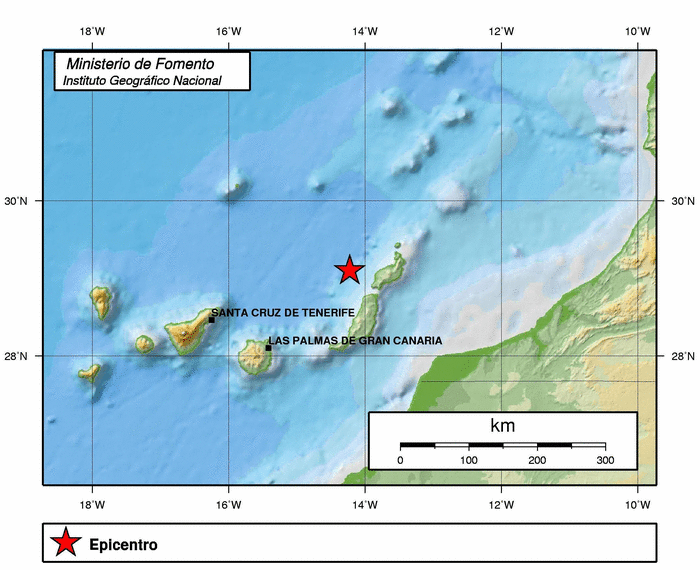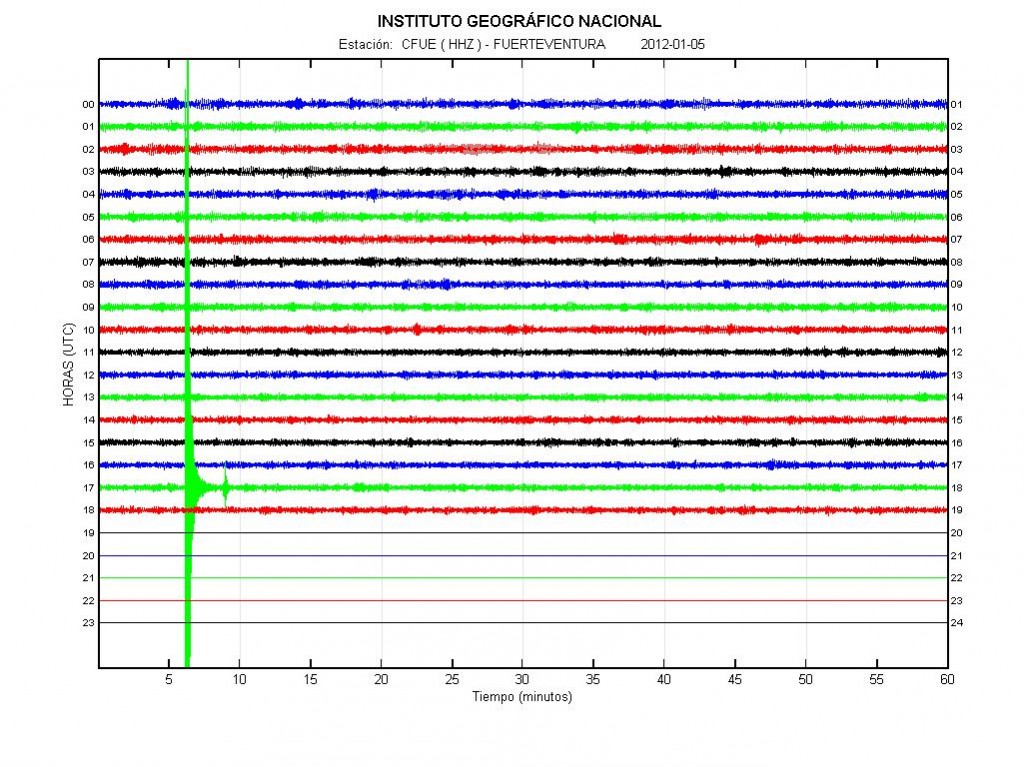Today at 17:05 UTC today (05.01.2012) there was an ML3.5 earthquake outside the Lanzarote (Wiki) and Fuerteventura (Wiki) Islands, in the Canary Islands. This earthquake was tectonic in nature, so no it not connected any volcano activity from what I can tell at current time. But I have limited data to base my opinion on. I do not know if this earthquake was felt. But given the distance to next population I find it unlikely to be the case.

The location of the earthquake according to IGN. Copyright of this picture belongs to IGN (Instituto Geográfico Nacional).

The earthquake as it did appear on the nearby seismometer. Copyright of this picture belongs to IGN (Instituto Geográfico Nacional).
According to this image there where two earthquakes that took place. Right after the ML3.5 earthquake an smaller earthquake did take place. But there is no size for it. But I am guessing that it is around ML1.2 in size (at least). No more earthquakes have been detected in this area since this earthquake took place earlier today.

Off topic related to Hekla and Katla:
Look at the recent Hekla eruptions.
Look how they usually fall around February, March or April.
1878, February, March, April
1913 April and May
1947 March and April
1970 May to July (a bit later)
1980 August (the exception)
1981 April
1991 January, February and March
2000 February and March
The interesting part is that if you go back in history, eruptions continue to mostly occur around winter-spring.
Likewise, I also noticed how Katla tends to erupt around summer and autumn.
Do you think these are mere coincidences?
If these patterns keep, then I would bet an eruption of Hekla again in late winter, and one of Katla in late summer.
Eruptions happen when they feel like it. This might look like pattern. But I think that this is more of an chance for most part.
Change in the seasons may have a very slight impact due to expansion or contraction of the rock or ice-cap. The volcano would have to be close to eruption anyway for this to have an effect.
But the apparent seasonality could also come from the time it takes for the magma reservoirs to fill.
So, as Jon says, it could just be co-oincidence.
We felt it in Lanzarote 🙂
Hi Jón
yesterday big eruption for 3 hours Etna vulcano, big plume ash 7 km over Sicily !
Come on in Italy !
photo spectacular taken at 07.30 local time
http://www.meteoweb.eu/2012/01/etna-eccezionali-foto-delleruzione-di-stamattina/108061/
best regards
Fulvio from Italy
Ciao
The smaller quake is probably below the 1.5 threshold that IGN publishes on the main list (last 10 days quakes).
Bob’s boiling away nicely this afternoon 🙂
http://www.hierroendirecto.movistar.es/
John, I was really very surprised indeed that you think the eruption in El hierro is over. Just checking the webcams today proves this is very far from the case. http://hierroendirecto.movistar.es/
Also the tremor charts today.
http://www.ign.es/ign/head/volcaSenalesAnterioresDia.do?nombreFichero=CHIE_2012-01-06&ver=s&estacion=CHIE&Anio=2012&Mes=01&Dia=06&tipo=1
wow, the eruption in no way over yet. Lots of steam and floating stones today!!
The eruption did end. But then it has been doing start-stop for several weeks now.
There is even an old blog post about it here, http://icelandgeology.net/?p=2010
I usually say an eruptions has “ended” when at least a week of no activity goes by. That all being said, El Hierro is pretty frustrating to watch when it does this on-off-on stuff!
Now there is smoke on the water, not only smoking stones. What does it mean? I don’t think that Bob is so near the surface?
http://www.ustream.tv/channel/acn-media#utm_campaign=synclickback&source=http://earthquake-report.com/2011/11/12/32535/&medium=8560089
I think it’s water vapor. Not dark smoke.
But continuous.
Looks like lots of smoking restingolites coming up but on a vastly larger scale than we have seen before. If you look closely when the actions slowls a little you can see lots bobbing around before they fill with water and sink again.
I don’t see the restingolitas even on a great screen. There are some “little” waves breaking sometimes. But perhaps the stones float away to the left. In older videos they swim some minutes i think.
Although there are also larger billows of steam that don’t seem to be explained by the above.
By above I mean what I wrote about the restingolites. sorry I didn’t notice you had psted Mafl17 863 siansag
The images this morning (and live now) look very much like ol’ Bob is getting close to the surface!!
http://volcanoscience.blogspot.com/2012/01/vigorous-steaming-at-el-hierro-volcano.html
New blog post is up about the new eruption in El Hierro volcano.